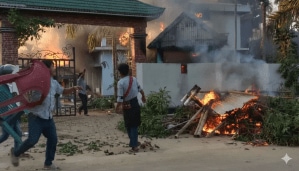
In September, there was an angry Indian response to Trudeau’s remarks with the Ministry of External Affairs calling the allegations “absurd and motivated”. After Canada expelled an Indian diplomat posted in Ottawa, Delhi expelled a Canadian diplomat based in New Delhi.
India then issued a travel advisory for Indian nationals travelling to Canadaand cautioned students, professionals and tourists. It suspended visa services in Canada and also stopped e-visa services — e-visas were resumed Wednesday.
India also forced Canada to withdraw 41 of its diplomats from its High Commission in New Delhi.
The Ministry of External Affairs described Canada as a “safe haven” for “terrorists, extremists and organised crime” — its sharpest words for a Western country in recent years, a language usually reserved for Pakistan and Afghanistan.
Contrast this with the Indian response to the FT report on Pannun and the US warning.
Story continues below this ad
Within hours, Arindam Bagchi, spokesperson for MEA, said, “During the course of recent discussions on India-US security cooperation, the US side shared some inputs pertaining to the nexus between organised criminals, gun-runners, terrorists and others. The inputs are a cause of concern for both countries and they decided to take necessary follow-up action.”
“On its part, India takes such inputs seriously since it impinges on our own national security interests as well. Issues in the context of US inputs are already being examined by relevant departments,” he said.
What stands out from the Indian responses in the two matters are:
* Consider the nature of the revelations. In Canada’s case, a person was killed and a murder investigation was ongoing. In the US case, the target of the alleged assassination plot was unharmed. The nature of the offence in the two cases were, therefore, different. In Canada’s case, Trudeau pointed fingers at the Indian government, while in the US case, it has not yet been directly linked to the Indian government.
Story continues below this ad
* In the Canada case, Trudeau made the statement in Parliament, apparently in a bid to pre-empt an article that was going to be published in a Canadian newspaper. In the US case, the administration did not deny the allegations in the FT report and merely said they “do not comment on diplomatic, law enforcement, or intelligence discussions with our partners”.
After the report, the US administration came out and NSC Spokesperson Adrienne Watson said, “We are treating this issue with utmost seriousness, and it has been raised by the US Government with the Indian Government, including at the senior-most levels.”
“Indian counterparts expressed surprise and concern. They stated that activity of this nature was not their policy. Based on discussion with senior US Government officials, we understand the Indian government is further investigating this issue and will have more to say about it in the coming days. We have conveyed our expectation that anyone deemed responsible should be held accountable.”
* The nature of India’s response has been different. In Canada’s case, Delhi rejected the allegations as “absurd and motivated”. And it refused to cooperate, and said that if some information is shared, then they will look into it. But in the US case, the Indian response was of cooperation and that “issues in the context of US inputs are already being examined by relevant departments”.
Story continues below this ad
* While the India-Canada ties are mostly economic and people-to-people, the Indo-US ties have much more depth and breadth. From strategy to defence, space to technology, economic to people-to-people, the ties with the US are much deeper and India has much more at stake.
This is the most strategically aligned partnership for India’s interests – politically and economically, and Delhi cannot afford to have a dismissive attitude towards US concerns.
The outcome of the investigations in both the US and India on this will determine the course of the ties. From past experiences, Washington and Delhi have learnt bitter lessons – the Devyani Khobragade affair was one such instance when both sides had suffered about six months of dip in ties from December 2013 to May 2014.
While this will be a test of the durability of the strength of their ties, the strategic nature of the ties is such that officials in both Washington and Delhi will show the diplomatic maturity to deal with this new crisis. Just like, Delhi and Ottawa are trying to de-escalate the crisis within two months of the spat.









